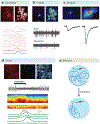Astrocytes and Behavior
- PMID: 33406370
- PMCID: PMC8257756
- DOI: 10.1146/annurev-neuro-101920-112225
Astrocytes and Behavior
Abstract
Animal behavior was classically considered to be determined exclusively by neuronal activity, whereas surrounding glial cells such as astrocytes played only supportive roles. However, astrocytes are as numerous as neurons in the mammalian brain, and current findings indicate a chemically based dialog between astrocytes and neurons. Activation of astrocytes by synaptically released neurotransmitters converges on regulating intracellular Ca2+ in astrocytes, which then can regulate the efficacy of near and distant tripartite synapses at diverse timescales through gliotransmitter release. Here, we discuss recent evidence on how diverse behaviors are impacted by this dialog. These recent findings support a paradigm shift in neuroscience, in which animal behavior does not result exclusively from neuronal activity but from the coordinated activity of both astrocytes and neurons. Decoding how astrocytes and neurons interact with each other in various brain circuits will be fundamental to fully understanding how behaviors originate and become dysregulated in disease.
Keywords: Ca2+ signaling; astrocytes; behavior; glia; gliotransmission; tripartite synapse.
Figures



References
-
- Adamsky A, Goshen I. 2018. Astrocytes in memory function: pioneering findings and future directions. Neuroscience 370:14–26 - PubMed
-
- Adamsky A, Kol A, Kreisel T, Doron A, Ozeri-Engelhard N, et al. 2018. Astrocytic activation generates de novo neuronal potentiation and memory enhancement. Cell 174:59–71.e14 - PubMed
-
- Andersen JD, Pouzet B. 2004. Spatial memory deficits induced by perinatal treatment of rats with PCP and reversal effect of d-serine. Neuropsychopharmacology 29:1080–90 - PubMed
-
- Arrigoni E, Chee MJS, Fuller PM. 2019. To eat or to sleep: That is a lateral hypothalamic question. Neuropharmacology 154:34–49 - PubMed
Publication types
MeSH terms
Grants and funding
LinkOut - more resources
Full Text Sources
Other Literature Sources
Miscellaneous

